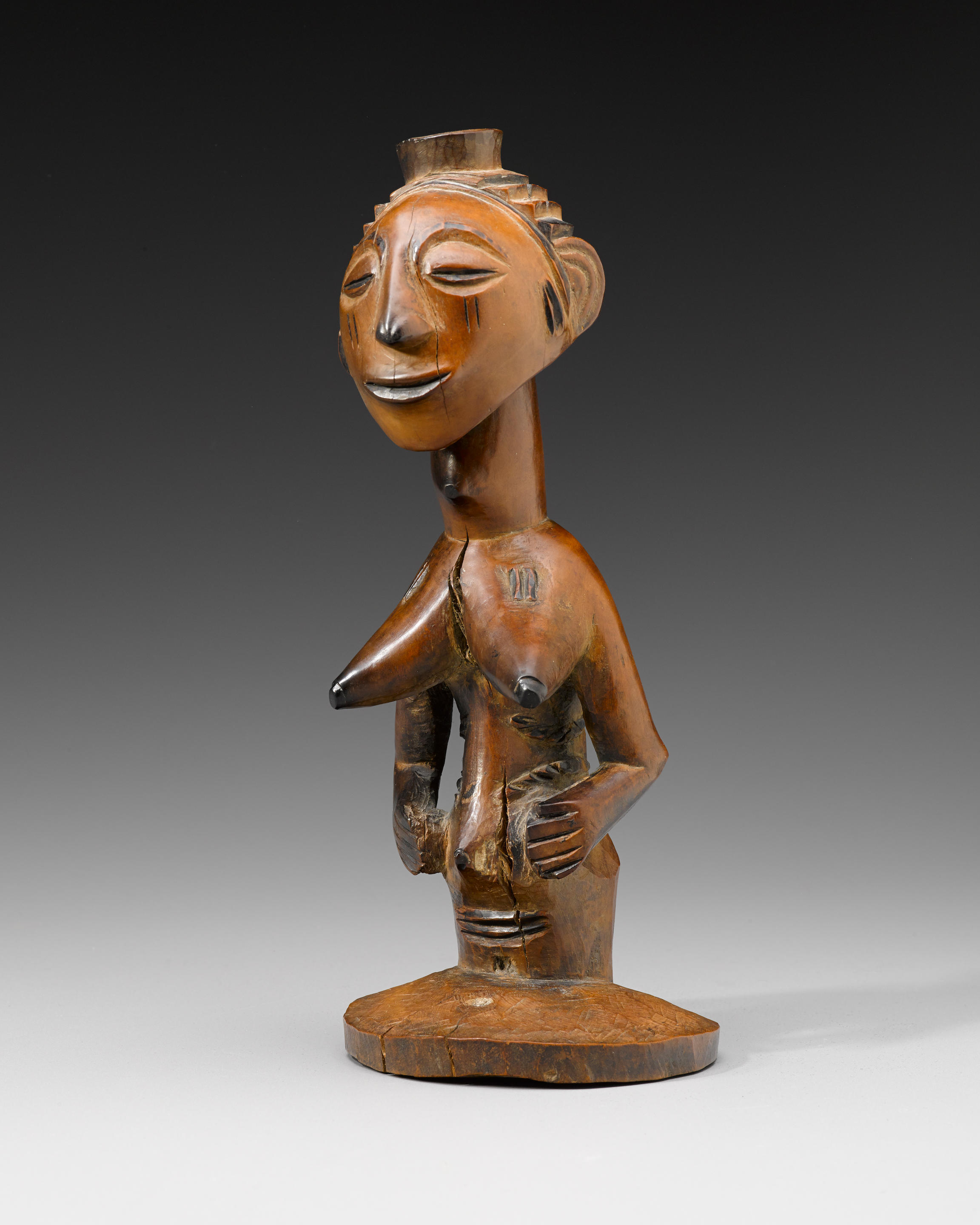kifwebe
Wood, pigments
Height 17in (43cm)
Provenance
Collected in situ by Edouard d'Orjo de Marchovelette, prior to 1952 (collection label "143" on underside of beak)
Patrick Didier Claes, Brussels
Private Collection
A letter of expertise by Didier Claes dated 20 June 2012 and a report by Bruno Claessens dated 20 November 2012 accompany the work.
Of rounded form, pierced around the edges for fiber attachments, the front with finely carved concentric lines accenting large coffee-bean eyes; divided vertically by the nose, the ridge of which extends to the top of the mask with a projection at the rim; the beak is open wide enough for the mask's wearer to view through (the eyes are not pierced) as the mask was worn with the beak horizontal; fine dark brown patina with kaolin highlights.
According to Claessens, only a handful of bukasandji beaked masks are known. The most documented example was acquired by Werner Von Grawert, a German military official in the Usumbura station in 1898-99, 1904-06 and then later in Ruanda-Urundi in 1906-07. The mask entered the Linden Museum in 1909 (Collection no. 58691); a second beaked mask is in the British Museum (Collection no. Af1904,0611.28), collected by E. Torday between 1900 and 1908; a third in The Patrick and Catherine Sargos Collection, Nancy, France, published in Arts et traditions d'Afrique du profane au sacré, Paris, 2010, p. 263, fig. 6.53 and front cover; and a fourth from The Pierre Dartevelle Collection, published in Volper (J.), Autour des Songye, Brussels, 2012, p. 84.
kifwebe
Wood, pigments
Height 17in (43cm)
Provenance
Collected in situ by Edouard d'Orjo de Marchovelette, prior to 1952 (collection label "143" on underside of beak)
Patrick Didier Claes, Brussels
Private Collection
A letter of expertise by Didier Claes dated 20 June 2012 and a report by Bruno Claessens dated 20 November 2012 accompany the work.
Of rounded form, pierced around the edges for fiber attachments, the front with finely carved concentric lines accenting large coffee-bean eyes; divided vertically by the nose, the ridge of which extends to the top of the mask with a projection at the rim; the beak is open wide enough for the mask's wearer to view through (the eyes are not pierced) as the mask was worn with the beak horizontal; fine dark brown patina with kaolin highlights.
According to Claessens, only a handful of bukasandji beaked masks are known. The most documented example was acquired by Werner Von Grawert, a German military official in the Usumbura station in 1898-99, 1904-06 and then later in Ruanda-Urundi in 1906-07. The mask entered the Linden Museum in 1909 (Collection no. 58691); a second beaked mask is in the British Museum (Collection no. Af1904,0611.28), collected by E. Torday between 1900 and 1908; a third in The Patrick and Catherine Sargos Collection, Nancy, France, published in Arts et traditions d'Afrique du profane au sacré, Paris, 2010, p. 263, fig. 6.53 and front cover; and a fourth from The Pierre Dartevelle Collection, published in Volper (J.), Autour des Songye, Brussels, 2012, p. 84.







/187453/Photo1%20data.jpg)


Testen Sie LotSearch und seine Premium-Features 7 Tage - ohne Kosten!
Lassen Sie sich automatisch über neue Objekte in kommenden Auktionen benachrichtigen.
Suchauftrag anlegen